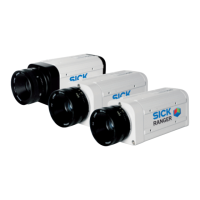Reference Manual Chapter 4
Ranger E/D
©SICK AG • Advanced Industrial Sensors • www.sick.com • All rights reserved 35
Ranger Studio
4.4.2 Adjust Exposure Time
To adjust the exposure time, Ranger Studio should already be connected to the Ranger.
10. Click Parameter Editor in the Ranger Studio.
11. If needed, expand the parameter tree by clicking on the +-signs.
12. Select the Image 1 component in the parameter tree.
All parameters for this component are listed to the right.
13. Select Exposure time and change the value until the laser line is visible in the Visuali-
zation tab, but not much else of the scene is. This means that the area not hit by laser
light should not be visible.
In many situations 3000 microseconds could be a good starting point, but this depends on
the surface properties of the object, lens settings and light sources.
When a suitable exposure time is found and the Ranger is measuring in free-running
mode, the same value should be given to two more parameters in the Parameter Editor:
14. Select the Measurement configuration in the parameter tree.
15. Select Cycle time and change the value to the same as you found as suitable expo-
sure time. The point in this example is that the cycle time should not exceed the expo-
sure time.
16. Select the measurement component under the Measurement configuration in the
parameter tree.
17. Select Exposure time and change the value to the exposure time you found suitable
above.
Note, when measuring in free-running triggering mode the lowest value of the cycle time
and the exposure time will be used as exposure time.
4.4.3 Set Region-of-Interest
The region-of-interest (ROI) is the area of the sensor image in which the Ranger will meas-
ure the object. By using a small ROI, the Ranger will normally be able to deliver profiles at
a higher rate.
18. Put the highest part of the object under the laser line.
19. Click Parameter Editor in the Ranger Studio.
20. Select the Image 1 component in the parameter tree of the Parameter Editor.
21. Select Measurement ROI overlay and change the value to 1.
This will display two animated dashed lines as an overlay in the Image 1 tab. The re-
gion in between these lines is used for 3D data acquisition. Initially the lines may be at
the edges of the window so you cannot see them. A good idea could be to enlarge the
window.
22. Select the measurement component in the Measurement configuration in the parame-
ter tree.
23. Repeat steps 24 – 27 until the ROI is defined properly.
24. Select Start row in the parameter tree and change the value until the upper most part
of the laser line is just beneath the fist dashed line.
25. Put the lowest part of the object into the laser plane.
26. Select Number of rows and change the value until the second dashed line is just
below the lowest part of the laser line projected onto the object.
27. Click Start to start the Ranger again.
In some cases it is a good idea to not include data from the background, for example the
conveyor belt.

